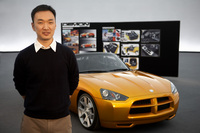Korean Car Designers On World Stage
GENEVA/SEOUL, March 9, 2007; Chang-Ran Kim and Cheon Jong-woo writing for Reuters reported that global automakers are tapping a rich seam of talented vehicle designers in a surprising spot: South Korea.
Despite its short history of car-making and national car brands little associated with design flair, the country is churning out a growing number of hot, young designers who are joining teams from Nissan Motor Co. to Mercedes-Benz as their technical skills, work ethic and creativity impress the carmakers' heads of design.
"When I first saw the sketches that Korean students were drawing, I was utterly shocked," said Shiro Nakamura, chief creative officer and head of design at Nissan, Japan's third-largest automaker.
"Their design is very emotional and powerful. I hate to say it, but they are miles ahead of Japanese students, both in terms of design sense and technique. There's no comparison," he said, adding that Nissan would likely hire more Korean designers this year than Japanese.
Much of that talent is being nurtured at Seoul-based Hongik University, South Korea's top fine arts school which offered its first transportation design course in 1990. Last year, the industrial design department doubled the number of places from the previous year to 120.
Others graduating from more established and famous schools such as the Art Center in California and London's Royal College of Art are also scattered around the globe, among them Jae Chung, designer of the Dodge Demon sports coupe concept car unveiled at this week's international auto show in Geneva.
"He was born in Korea and went to school in Pasadena. And it's just like anything -- you get exposed to the school, you get exposed to Chrysler and Dodge and out comes this new aesthetic," Ralph Gilles, vice president of design for Chrysler, told Reuters at the auto show. Fellow Art Center alumnus Han Seung Lee at Honda Motor Co. designed the Sports 4 Concept unveiled at the Tokyo Motor Show in 2005.
"There's a real passion among Korean designers to advance and succeed that exceeds what you see in Japanese students," said Koichi Hayashi, deputy general manager of design at Japan's Mazda Motor Corp., which employs four Korean designers at its headquarters in Hiroshima.
GODSEND FOR JAPANESE CARMAKERS
The bold and sometimes over-the-top style often associated with designers graduating from South Korea has its critics -- including Chrysler's Gilles.
"There's a very distinct difference in the stuff I see coming straight from Korea," he said.
"They tend to be inspired a lot by nature: animals, aquatic details and what not. Sometimes in terms of a vehicle those aesthetics can be forced. It's still a machine."
For Japanese automakers, though, the growing army of eager Korean designers are a godsend.
Because the two countries share a similar language structure and working culture, Koreans immediately have an advantage over their Western colleagues, they said. And Korean design school graduates are often more willing to work at the relatively low starting salaries of Japanese companies.
"All the pieces are in place," Nissan's Nakamura said, with a tinge of concern for his Japanese compatriots studying design.
"Right now, young Korean designers are most sought-after by Japanese carmakers, but they can make it in the West anytime."
However, Korean students may eventually face stiffer competition from China, Russia and India where design pupils are sharpening their skills with equal zeal. Chung Joo-hyun, a professor in Hongik's industrial design department, is determined to ensure his students continue to have the edge over rivals.
"We have such talented students, and they spend so much time and effort out of the classroom," said Chung.
"I train them very hard, just like in the military service. No one is allowed home unless I give them permission."
(Additional reporting for Reuters by Kevin Krolicki)



